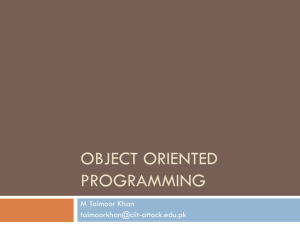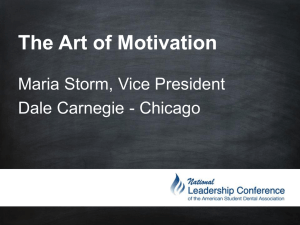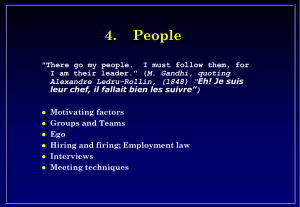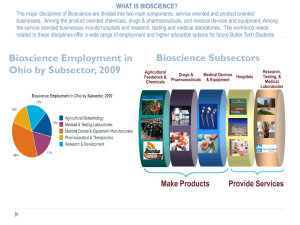Object Oriented Programming - Universitatea de Vest din Timişoara
advertisement
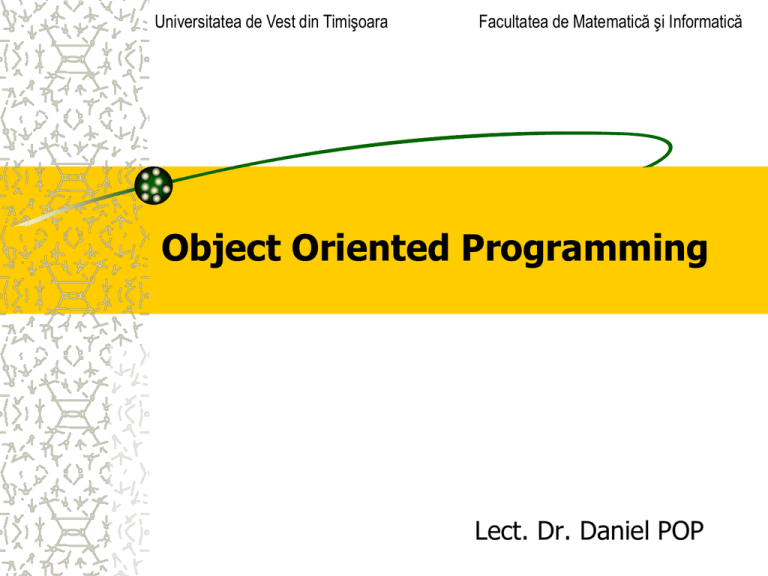
Universitatea de Vest din Timişoara
Facultatea de Matematică şi Informatică
Object Oriented Programming
Lect. Dr. Daniel POP
Course #2 Agenda
Abstraction
Abstraction definition. An example
Encapsulation: data and function members
• Basic object-oriented concepts:
• Class
• Object
• Message
Programming II
Object Oriented Programming
2
Abstraction
Abstraction: (real-life/human) Problem (computer/machine) Model
Model
– Data
– Operations
DEFINITION [Abstraction] Abstraction means structuring a real-life
problem into well-defined entities by defining their data and
operations.
Remark: It’s a general process with no direct link with a programming
language.
How to represent an abstraction:
– using mechanism provided by a programming language (e.g. class in C++/Java)
– using graphical representations offered by a modeling language (e.g. rectangle in UML)
– using textual/non-standard description
Programming II
Object Oriented Programming
3
Example
Modeling employees of an institution
Candidate properties of an employee: name, address, date of birth,
hair color, CNP etc.
Employee (Textual representation)
– Data
•
•
•
•
Name
Address
Date of Birth
CNP
– Operations
• CRUD: Create/Read/Update/Delete
• Assign to a particular department
• Access to data (name, address etc.)
Programming II
Object Oriented Programming
4
Example: Employee (UML representation)
Employee
- name: String
- address: String
- CNP: String
- DoB: Date
+ create(): Employee
+ update(): Employee
+ delete(Employee)
+ assign(Department)
Programming II
Object Oriented Programming
5
Example: Employee (C++ representation)
Employee.h
Employee.cpp
class Employee {
String name;
String address;
String CNP;
Date DoB;
Department department;
public:
Employee create();
Employee update();
void delete();
void assign(Department& d);
};
Employee Employee::create() {
name = “”;
address = “”;
CNP=“0000000000000”;
DoB.init(“1/1/1900”);
}
Employee Employee::update() {
// statements
}
void Employee::delete() {
department.remove(this);
}
void Employee::assign(
Department& d) {
d.add(this);
department = d;
}
Programming II
Object Oriented Programming
6
Data type
DEFINITION [Data type] Data type =
– possible values of the type
– The way values are stored (internal representation in
memory)
– operations applicable
Examples: predefined (built-in): int, float, double,
char, void etc, or user-defined: Employee, complex
etc.
Programming II
Object Oriented Programming
7
Encapsulation
DEFINITION [Encapsulation] The principle of hiding the data structures and to
provide a well-defined, public interface to access them.
Example: representation of complex numbers
complex.h
user.c
struct complex {
double re, im;
};
void f(complex c) {
double d1 = c.re, d2 = c.im;
}
complex.h
user.c
struct complex {
double v[2]; // v[0] – real part,
// v[1] – imaginary part
};
void f(complex c) {
// Error
double d1 = c.re, d2 = c.im;
}
Programming II
Object Oriented Programming
8
Basic object-oriented concepts: Class
DEFINITION [Class] A class is the implementation of a
data type (concrete, abstract or generic). It defines
attributes and functions(*) which implement the data
structure and operations of the data type, respectively.
Example:
complex.cpp
class complex {
double v[2]; // v[0] – real part,
// v[1] – imaginary part
public:
double real() { return v[0]; }
double imag() { return v[1]; }
};
Programming II
(*) Remark: Functions are also called
methods. In [Stroustrup, 1997] a clear
distinction is made between functions
and methods. A method is a virtual
function. This terminology will be
followed throughout this course as well.
Remark: Classes define properties and
behaviour of sets of objects.
Object Oriented Programming
9
Basic object-oriented concepts: Object
DEFINITION [Object] An object is an instance of a class. It can be uniquely
identified by its name, it defines a state which is represented by the values of its
attributes at a particular time and it exposes a behaviour defined by the set of
functions (methods) that can be applied to it.
An OO Program = collection of objects that interact one with another.
Example:
void f() {
complex a = 2.3;
complex b = 1/a;
complex c = a+b*complex(1,2.3);
c = -(a/b)+2;
c.print();
}
Programming II
Object Oriented Programming
Object4
Object2
Object3
Object1
How are objects internally
represented in C++?
10
Basic object-oriented concepts: Message
Q: How does objects interact? This is the question ;)
A: By sending messages from one object to another asking the recipient to apply a method on
itself.
DEFINITION [Message] A message is a request to an object to invoke one of its functions. A
message contains:
– the name of the function;
– the arguments of the function.
Sending a message is achieved in C++ by: ‘.’ or ‘->’ or any other overloadable operator
void container::draw(RenderingDevice rd) {
for(int i=0; i < count; i++)
shapes[i].draw(rd);
}
void f() {
complex c = a+b*complex(1,2.3);
// or, equivalent to
c.set(a.add(b.multiply(complex(1,2.3))));
}
How objects interact in
C++?
Programming II
Object Oriented Programming
11
Exercise
Choose one of your daily tasks (not too complex) and
describe it in procedural and object-oriented forms. Try
to design it as a world of interacting objects.
Programming II
Object Oriented Programming
12
Further Reading
[Bruce, 2002] Kim B. Bruce – Foundations of Object-Oriented Languages, MIT Press, 2002 [Section
1.1, Page 4-7]
[Mueller, 1996] Peter Müller – Introduction to Object-Oriented Programming Using C++, Globewide
Network Academy (GNA) www.gnacademy.org, 1996 [Chapter 3-4]
[Stroustrup, 1999] Bjarne Stroustrup - An Overview of the C++ Programming Language in “The
Handbook of Object Technology” (Editor: Saba Zamir). CRC Press LLC, Boca Raton. 1999. ISBN 0-84933135-8 [Section 4.2, Page 10-11]
[Goguen, 1978] J.A. Goguen, J.W. Thatcher, and E.G. Wagner - An initial algebra approach to the
specification, correctness, and implementation of abstract data types. In R.T. Yeh, editor, Current Trends in
Programming Methodology, volume 4. Prentice-Hall, 1978
[Guttag, 1977] J.V. Guttag - Abstract data types and the development of data structures. Communications of
ACM, 20(6):396–404, 1977
[Pop, 2003] Daniel Pop – C++ Programming Language Lecture Notes
[Stroustrup, 1997] Bjarne Stroustrup – The C++ Programming Language 3rd Edition, Addison
Wesley, 1997 [Section 4.9.4]
Programming II
Object Oriented Programming
13
Backup Slides
Programming II
Object Oriented Programming
14
Abstract Data Types
Introduced by Goguen 1978 and Guttag 1977 [Goguen 1978, Guttag 1977]
DEFINITION [Abstract Data Type] An ADT is characterized by the following
properties:
– It exports a type;
– It exports a set of operations (the interface) that are the one and only
access mechanism to the type’s data structure;
– Axioms and preconditions define the application domain of the type.
Multiple instances of an ADT
How to represent an ADT:
– using mechanism provided by a programming language (e.g. class in C++/Java)
– using graphical representations offered by a modeling language (e.g. rectangle in UML)
– using textual/non-standard description (e.g. see Employee on previous slide)
Programming II
Object Oriented Programming
15
Generic Abstract Data Types
List of cars, facts, events, students etc.
Additional parameter that specifies the type of objects stored in a list
=> generic parameter specified when a new variable is created.
Ex: List<Student> anYear;
List is a generic abstract data type
template <class T> class List {
T *v ;
int max_size, top;
public:
List (int s) { top = 0 ; v = new T[max_size = s]; } // constructor
˜List() { delete [] v ; } // destructor
void insert (T c ) { v[top++] = c ; }
T get(int index) { return v[index]; }
};
Programming II
Object Oriented Programming
16
Abstract data types and object-oriented programming
Object oriented programming is one possible
“implementation” of ADT
Data abstraction
Abstract data type
Generic abstract data type
Object-oriented programming
(abstract) class
Template class
Instance of an (G)ADT
Operations
Attributes
Object
Member function (of a class)
Data members
Programming II
Object Oriented Programming
17


